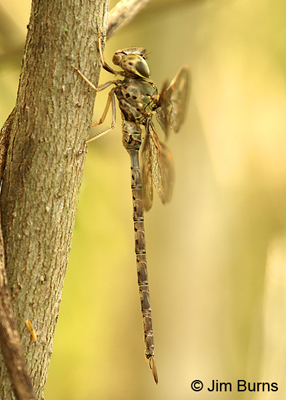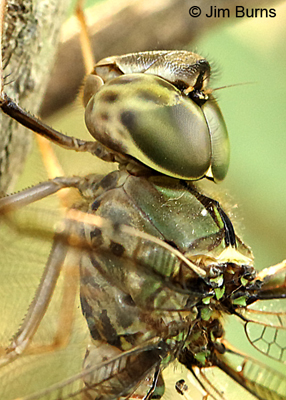
Much is made of the cryptic coloration of many of our bird families, the owls and nightjars most notably, and these and some other birds can be so difficult to spot in habitat that birders often just say they find you, and that, only if you’re lucky. Be that as it may, most birders getting into odonates soon learn they must narrow their field of focus for dragons and damsels, adjusting from eye level and above, middle distance and out for birds, to eye level and below, middle distance and in for odonates.
This focus adjustment is both visual and mental, and it is so necessary that most birders find it impossible to successfully bird and ode (yes, that’s a verb too in the same sense that bird can be) at the same time or on the same field trip. This in itself partially accounts for the difficulty of finding odonata, but as birders travel deeper into the dark side many other reasons become apparent, not the least of which is the most obvious—dragons and damsels are much smaller and smaller objects are harder to see.
Birds, some kinds of birds at least, can be found anywhere and everywhere. In North America there are roughly twice as many avian species as odonate species, and representatives of the former can be found at any time of year in any kind of habitat. Dragons and damsels, not so much. Almost all are seasonal, many are highly localized. A few occupy such small ecological niches they can be found only in a few counties in the entire country! Furthermore, odonates, perhaps simply because they are smaller, are more quickly affected by habitat and climate change which can further decrease their numbers.
Have we left anything out? Well, yes--something birds and odes have in common that is often overlooked in the case of the latter because they are so small. Often it is the darners that first catch the interest of beginners because they are large, colorful, and spend a lot of time on the wing. One group, however, the Two-spined Darners, is an outlier, large but drab brown and forest green, and crepuscular, and they bear the common names Bar-sided Darner and Twilight Darner.
Both are locally common, the former in many of the popular birding hotspots of south Texas, the latter throughout peninsular Florida, but good luck finding one because during the day they hang up in wooded areas resembling, with their dull colors, nothing so much as just another twig. My first Bar-sided zipped past me early one morning as I walked a shaded path in Santa Ana NWR, and I was lucky enough to see it hang up a foot off the ground twenty yards away. That was when I discovered odonates can be every bit as much about cryptic coloration as any of our well camouflaged bird families.
Having specifically targeted and looked for this darner on more than one Texas birding trip, I hurriedly spread my tripod legs and snapped off a few shots with my telephoto lens without spooking it, but then got creative and crept up on hands and knee pads with my macro lens. I captured the images I wanted, close and diagnostic, but when I put them on the computer something about the thorax pattern, something I couldn’t quite place, gnawed at the corners of my mind.
A couple days later, as I reached for a hat, a camouflage patterned one, it came to me. The thorax and abdomen, indeed the entire body, of the Bar-sided Darner could have been used in a Cabela’s or Bass Pro catalogue on the pages showing the Realtree camo clothing favored by hunters. Little wonder, really, that many odonates are difficult to find, especially when perched in habitat.